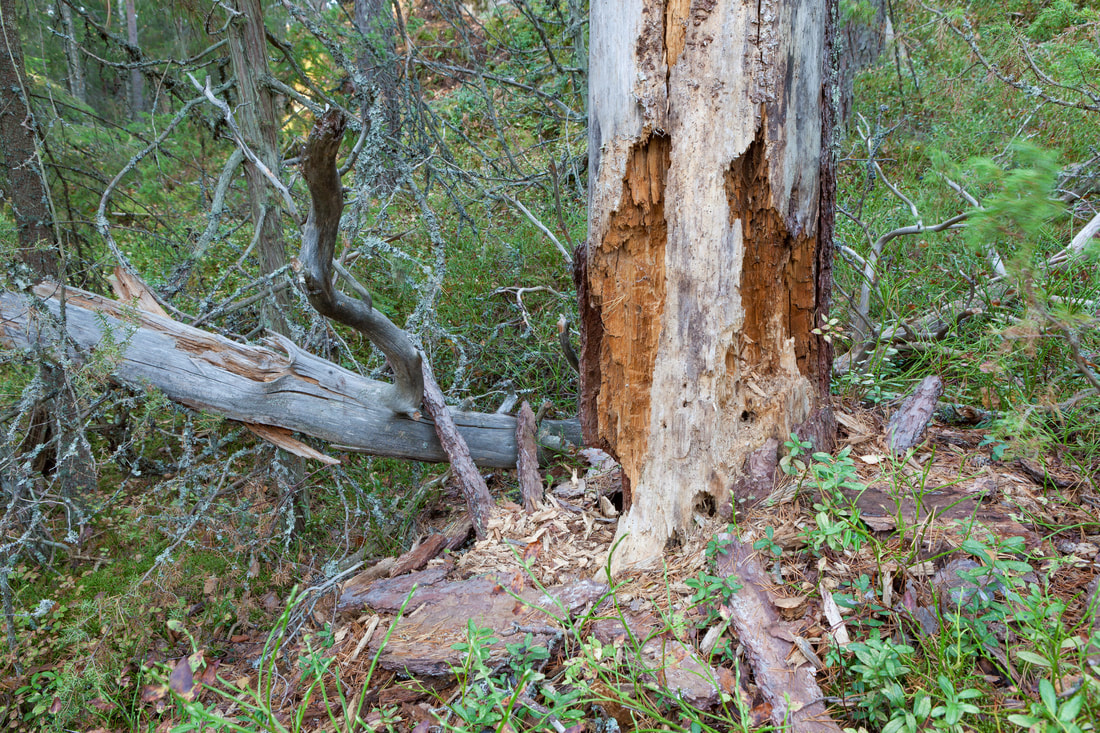|
Trees are some of the most valuable and beautiful living things on earth. They provide oxygen, shade, building materials, and are a key part of the beauty of many parks and yards.
However wonderful trees are, unfortunately there comes a time when cutting down the tree is necessary. It's important to find out if you have a dying tree on your property so you can address the problem before it becomes a safety hazard. Keep reading to learn about 7 ways to tell if your tree too sick to save. 1. It Has Few LeavesDeciduous trees lose their leaves each year, of course. But, if few leaves come back, or if the tree loses most of its leaves before it should, it's a sign the tree may be dying. Dying trees may also hang onto their autumn leaves well into the winter, after they should have fallen to the ground. Any abnormal leaf activity could be a bad sign. Evergreen trees can also show signs of distress through their needles. If their green needles turn brown, red, or yellow, that is a serious sign the tree might be dying, or at least needing immediate attention. If only one side of the tree looks bare, that could still mean you need to cut the whole tree down, since living and dead parts of the tree make it unbalanced and likely to fall over. Tree removal is our specialty, so don't hesitate to ask for a professional opinion. 2. It Has Several Dead LimbsA few dead branches are not usually a big deal. They just fall to the ground and the tree continues just fine. However, if there are several, large limbs and branches that are dying, that is a serious concern. As more and more branches die, the structural integrity of the tree is diminished. Regular maintenance can address some dead branches, but once it passes a certain point, the tree is dying and will need to be cut down for safety. 3. The Bark Is Chipping AwayAs trees begin to die, their bark becomes very brittle and falls off the tree in large chunks. It could also develop long vertical cracks that go from near the ground and up the tree. Multiple deep splits in the bark that keep getting worse are bad signs for the life of the tree. The same is true of problems with the bark that gets worse with each rainfall or strong windstorm. 4. There Is Visible Root DamageRoots are usually hard to see, but there are some situations that might reveal root damage. The most obvious is when the root system is too shallow and can be seen growing above the ground. This is not normal and signifies the tree is not healthy. Healthy trees have huge, deep root systems. It can be hard to know exactly where the roots extend. So, if you are digging or doing construction work in your yard, there is a chance you may inadvertently damage the roots. If the damage is serious enough, it may endanger the life of the tree (and is certainly a danger to you if it leads to the tree falling). Even if you can't see the root damage, trees that suddenly lose color or look unhealthy could have sustained root damage. 5. The Tree Develops a TiltIf an otherwise straight tree develops a lean, it's an indication it may be dying. This could happen suddenly or slowly over the course of time. A very strong storm may damage a tree and cause a lean to develop immediately. However, most winds and storms do not permanently affect the tree. If the tree can't withstand moderate winds, it is not healthy. Root damage or other longer-term health issues could lead to a slow-developing lean. Either way, a leaning tree is both unhealthy and a safety risk. 6. It Has an Insect InfestationTrees provide great habitat for many insects and other animals. But, they can also become too infested with insects. When this happens, it is detrimental to the tree. There are lots of insects that cause problems for trees in Florida. Some insects, like bark beetles, seek out dying trees. If your tree is full of these beetles, it's another sign that the tree is on its way out. 7. The Wood Below The Bark Is BrownWhile the bark is supposed to be brownish, the layer of wood just below the bark, called the cambium, is green when healthy. In order to test this, you'll have to make a small incision in the tree. Cut down past the bark and take a look. If the wood is green, that's good. If it appears brown and dry, that's a sign the tree is dying. Test multiple areas around the tree to be sure. This is sometimes called the scratch test, and it won't harm the tree. Call The Professionals If You Have a Dying TreeA dying tree poses a big risk to you, your family, and your home. It's always sad to have to cut down a tree, but it needs to be done before the tree falls and does damage. If you have evaluated your tree and seen some of the above signs that it's dying, please contact us right away. Or, if you just have some tree-related questions, feel free to reach out. Our experienced arborists can evaluate the situation and let you know the best course of action, whether that's a good trim or cutting it down. Just like you, we love trees and want you to enjoy them safely.
17 Comments
2/2/2021 12:14:10 pm
You made a good point that seeing falling branches or parts could mean that the tree is about to perish. My friend noticed that after his uncle passed away, most of his oak trees are showing weird rotting spots all over them. He should probably contact a tree removal expert before these trees pose a risk for his family.
Reply
2/17/2021 02:53:18 pm
It's good to know that root issues can cause sick trees to develop a lean or tilt over time. My sister came to visit last night and mentioned the large tree in our front yard looked more tilted than it used to. Thanks for letting me know the tree could be dying so I can have it checked out and potentially removed soon!
Reply
3/30/2021 02:43:28 pm
I didn't know that your tree may be dying if you notice that it is beginning to lean. My wife and I would like to get rid of one of our trees. We'll be sure to have it removed before it suffers from further decay.
Reply
7/8/2021 04:15:46 pm
It was really helpful when you said that large dead branches are a sign that your tree is dead. My husband and I have noticed how a lot of branches on the tree in our backyard are dead, and we were wondering if that was a bad sign. We'll have to look into hiring a tree removal service to come and remove it for us as soon as possible.
Reply
12/5/2021 02:44:27 am
So informative things are provided here,I really happy to read this post,I was just imagine about it and you provided me the correct information I really bookmark it,for further reading,So thanks for sharing the information.
Reply
4/20/2022 08:01:46 pm
Your point about how a dying tree could start to lean and become a safety risk is good to know. There is a tree in my friend's yard that I noticed when I was at her house yesterday that is beginning to lean. I will suggest that she hire a professional service to check the tree out and remove it if necessary before it causes any harm.
Reply
8/3/2022 09:11:06 pm
Thank you so much for the warning about how tree removal is a very risky thing to try to do yourself. With how large the dying tree on our property is, I can really see this being problematic for all of us, especially since the weather is also quite unpredictable at this point. As soon as I find a tree removal expert in the area, I'll get them to assist us with whatever that tree needs.
Reply
10/25/2022 09:38:46 am
There's a tree on my property that has been dying, and I'm not sure what to do about it. It makes sense that I would want to get a professional to take a look at a professional to help me out with this. That seems like a good way to ensure that we handle things correctly.
Reply
11/11/2022 01:06:13 pm
Thanks so much for the list of signs that it's just time to remove a tree. My parents have this old tree in their yard that isn't doing well anymore. My mom doesn't want to get rid of it but is afraid she has to. We've been looking into calling down a tree removal company to help her take care of it.
Reply
11/14/2022 04:35:31 pm
It was interesting to me when you mentioned that a tree with few leaves is a sign that it is dying. If you have a dying tree, you would probably want to remove it so that you can plant a new one. In order to remove a tree safely, it would probably be a good idea to contact an arborist.
Reply
2/24/2023 04:55:32 pm
I'm glad you described decayed trees that need removal and how to identify them. Recently, my mom told me she's been worried about one of her trees since she saw a lot of insects around it, so I think my mom needs to read your article now, even if it makes her sad. I appreciate your intake about how some insects seek dying trees, which helps you identify a diseased one.
Reply
Thanks for helping me understand that trees will hang on to their autumn leaves when they are about to die. I wonder if that is the situation with the one in our backyard this week. It would be helpful to hire an emergency tree removal as soon as possible to inspect it for us so that we can prevent it from falling onto our roof if it suddenly collapses.
Reply
4/12/2023 05:15:45 pm
It makes sense that fewer leaves are a bad sign. My husband and I have noticed how the tree in our backyard has started to grow fewer leaves this spring than it usually does, so I wanted to know if that meant that something is wrong. We'll have to look into hiring a professional to come and remove it for us as soon as possible.
Reply
5/23/2023 10:32:26 am
"Kudos to you for addressing this important topic. Your insights have given me a fresh perspective."
Reply
7/3/2023 07:22:48 am
Hey there, I think we need to bring more ideas for this purpose.
Reply
7/21/2023 02:33:58 am
Terrific post, I’ve bookmarked this site so hopefully I will discover much more on this topic in the foreseeable future
Reply
5/8/2024 09:53:49 am
Training provides them with the knowledge to assess tree health accurately, diagnose issues, and implement appropriate treatments, leading to healthier trees and landscapes.
Reply
Leave a Reply. |
AuthorWe tackle all the jobs the same, no job is to small or to big. Call us today at |
|
FEMA APPROVED
|
|
|
Riverview Tree Service
|

 RSS Feed
RSS Feed
